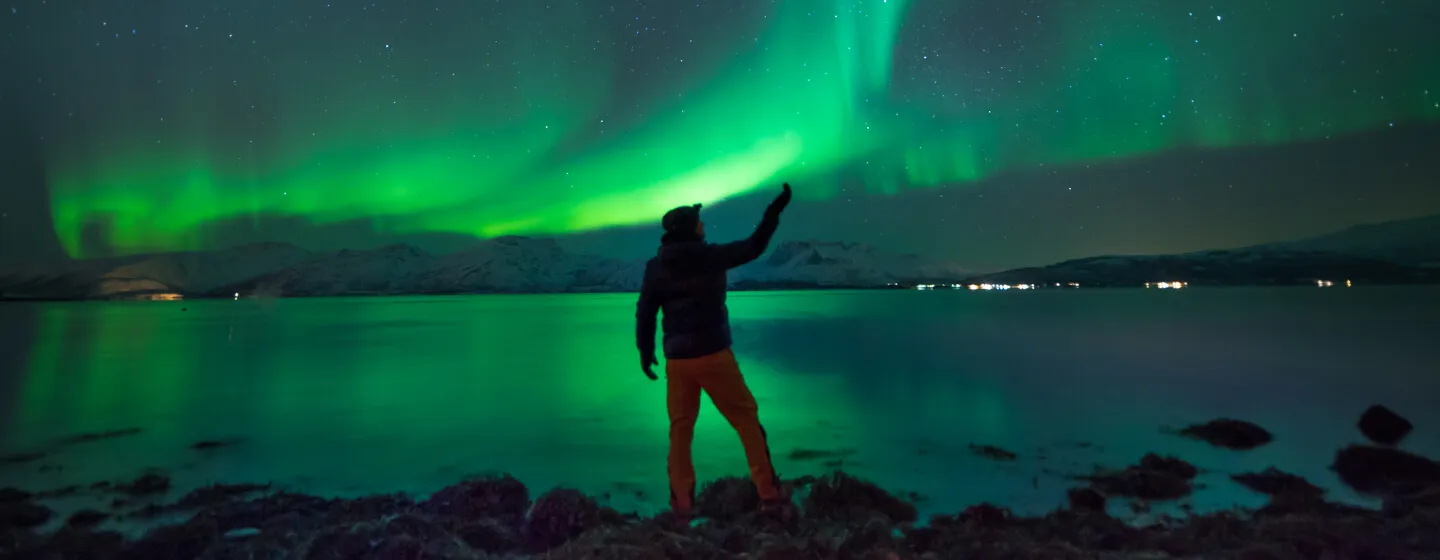Urban experiences meets raw Arctic nature
Look out for the northern lights
A bit of planning and newly acquired knowledge enhance your chances of a successful hunt for the Northern Lights! Keep reading to learn more about the mystical light that often colours our night sky from August to April.
The Northern Lights oval is directly above us
The reason why the Tromsø region is one of the best, if not the very best, places on earth to see the Northern Lights is our geographical location. Tromsø is located directly below the Northern Lights oval, which is a continuous ring of Northern Lights situated above the Earth’s geomagnetic North Pole. The Northern Lights are present within this oval around the clock and all year long. However, it’s too bright to see the Northern Lights during the daytime and in the Midnight Sun during the summer. The best time to see the Northern Lights is when it starts to get dark, from late August early April.
The Polar Night offers beautiful light
North of the Arctic Circle, the sun does not rise above the horizon from mid-November to mid-January. This period is known as the Polar Night. Don’t be put off by the fact that it’s referred to as night. Even on the shortest days, there are a few hours of twilight in the middle of the day. During this spectacular time, tones of pink and blue are smeared across the winter blue sky. This may well be the most beautiful light you ever experience.
If we are lucky, the mystical aurora will glitter with its presence as evening falls. Our best tip to get the best possible experience of the Northern Lights is to get away from the bright city lights. Head to places outside the city centre with little or no artificial light. For the ultimate Northern Lights experience, we recommend joining an organised tour. As well as knowing the local area well, the guides monitor the weather and aurora activity, which increases your chances of spotting this natural phenomenon.
You need somewhat stronger Northern Lights activity to see the Northern Lights on evenings around full moon. However, the moon and natural moonlight contribute to making the nature and Northern Lights experience even more special than usual, as well as creating wonderful photos. While the best time to see the Northern Lights is from 8pm to 2am, there are also good chances before and after these times if the weather conditions are right.
That’s what makes it so exciting: You never know when or where the magical light will appear. Suddenly it reveals itself, and suddenly it’s gone again. Our best advice is to be patient and stay outside so you can gaze up at the night sky.
Auroral cycles and solar activity
This may sound complicated, so we will try to explain it in a simple way.
The best known of sun’s many cycles is the eleven-year cycle. This occurs roughly every eleventh year when the sun enters a period with a solar maximum. During this period, the sun gets sunspots and there is high solar activity with many solar storms.
Owing to the high solar activity, the Northern Lights can also be experienced further south as the Northern Lights oval extends further south during this period. Some people believe that the Northern Lights become even stronger here in the north during periods of high solar activity and weaker during low solar activity.
However, research in Northern Finland to measure actual Northern Lights outbreaks over many years has found no connection between the 11-year cycles and actual observations of the Northern Lights in the area around the Northern Lights oval. When the famous British actress, Joanna Lumley, visited Tromsø and Northern Norway in 2008, it was a year of low solar activity. However, she still managed to see several powerful and magical Northern Lights outbreaks.
Click here to read a more in-depth article about how the Northern Lights occurs.
Cloudless skies are best
The weather is one of the most important factors to consider when you are hunting the Northern Lights. The Northern Lights occur at least 80 km above the Earth’s surface, but the highest clouds are no more than 5 or 10 km high. This means that we need cloudless or at least partly cloudless sky to be able to see the Northern Lights. It’s still possible to see the Northern Lights with some cloud cover, but a clear sky is preferably. There may be major variations in the weather within the Northern Lights oval. This may include extremely local variations, and the weather changes faster than you may think. In other words, don’t worry if it’s cloudy because there may suddenly be a hole in the cloud cover – and the Northern Lights may appear!
Tromsø – the perfect base
Many people prefer Tromsø as the base for their Northern Lights hunt, and we understand why. Tromsø is an urban melting pot, close to wild and beautiful nature. Owing to the Gulf Stream, the Tromsø region offers relatively mild temperatures. In fact, it’s often referred to as “mild Northern Lights country”.
We recommend booking Northern Lights experiences and accommodation well in advance. The Tromsø region offers accommodation options to suit every taste and budget. There is also a wide range of Northern Lights activities, which can at times be fully booked. All our Northern Lights activities can be booked here.
We hope you are lucky enough to experience the green magic that forms such an important part of our lives for many months of the year! Even though we are used to seeing it, we still pinch ourselves often and get just as excited every time it dances across the night sky.
